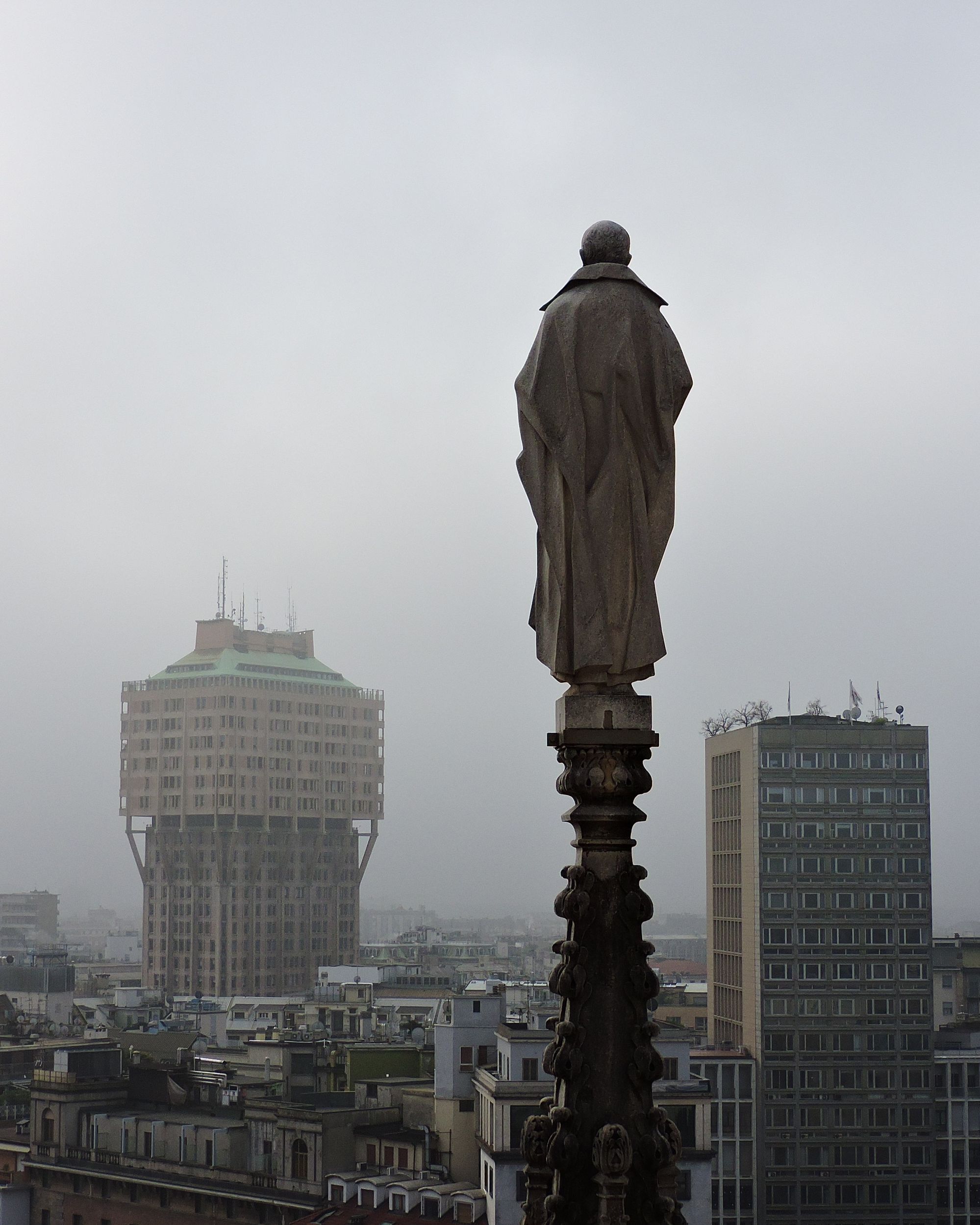
Is Milan's polluted air a political issue now? Between petitions, contradictions and very uncomfortable questions
In Milan the air is polluted due to smog for years, perhaps decades (who remembers the foggy days of the 80s and the Duomo black as a piece of coal?) but recently the situation has worsened, despite the green transition: for days now the air quality map on iPhones shows a worrying purple spot over the entire Po Valley, on sunny days the air appears almost opaque as if there was a constant haze that doesn't want to go away, rain doesn't seem to be coming. And even the official, objective data does not provide much comfort: after a January with data fluctuating between PM2.5 and PM10, with the Lombardy Region forced several times to activate level 1 and 2 anti-pollution measures, at the beginning of February it seemed that rain and wind would clean the air; but in the following days the situation seems to have worsened.
c'è il sole, non una nuvola in cielo, eppure i palazzi in fondo non si vedono bene, sono foschi come se ci fosse la nebbia. ma la nebbia non c'è e beppe sala dice che l'inquinamento a milano non è un problema
— buccia (@moltitudo) February 20, 2024
In these days, a Milan citizen, Francesca Amami, launched a petition on Change.org to ask Mayor Beppe Sala and the Municipality of Milan for urgent interventions for air quality. "I, a resident of Milan, together with many other citizens, are deeply concerned about the increasing air pollution in our beloved city. We live in Milan and care about our health. Air pollution is a real and constant threat that is having a negative impact on our health and well-being," she writes in an appeal that has gathered several thousand signatures in less than twenty-four hours. According to Amami, it would be necessary to consider the "adoption of stricter policies on vehicle emissions, the strengthening of eco-friendly public transport, the promotion of sustainable mobility such as cycling or walking." All noble and valid proposals that, however, bring to mind the various protests that arose with the closing of the historic center to cars and Mayor Sala's dream of turning the city center into a huge pedestrian area, the continuous difficulties of ATM which for the entire 2023 held two strikes per month, always on Fridays, and now begins to find itself with personnel and security problems as well as many other issues that come into play in a very vast and hardly manageable framework.
What does Mayor Sala say?
@il.giornale "Milano è la terza città più inquinata al mondo? Sono le solite analisi estemporanee gestite da un ente privato". Il sindaco di Milano Beppe Sala liquida così diversi studi e indicatori che danno tutti la stessa sentenza: la qualità dell'aria a Milano è pessima per la presenza di smog che non attanaglia soltanto la Città metropolitana ma anche il suo hinterland e gran parte della Pianura Padana. Domenica 18 febbraio è stata quasi da record mondiale negativo visto che il capoluogo lombardo ha registrato una concentrazione di polveri sottili di oltre 27 volte i limiti consentiti dall'Organizzazione Mondiale della Sanità (Oms) e stimata nel valore di 193. Eppure, i dati consultabili nel portale svizzero IqAir sugli indici di qualità sono chiari: ieri Milano sarebbe risultata la terza città con la peggiore qualità dell'aria al mondo dietro soltanto a Lahore (in Pakistan) e Dacca (Bangladesh) con livelli di Pm2.5 che hanno sfondato abbondantemente quota 200. Leggi l'articolo su #IlGiornale nel primo commento #Milano #BeppeSala #smog #inquinamento suono originale - il Giornale
The Mayor of Milan, Giuseppe Sala, questioned yesterday by journalists at the conference Cohesion and territorial and local autonomy organization at the Prefecture, reiterated in a already viral video the importance of the measures taken to address air pollution, despite the comparison with the data presented by IQAir. Sala stated: "It's the usual extemporaneous analysis managed by a private entity. We should understand who does these analyses, because Arpa's analyses show the exact opposite." Referring to how, in fact, IQAir, the company that published the news, is a private entity that sells air purifiers: "I'm also amazed by you, you can't just report news read on social media. Who does these analyses? Arpa does other analyses that show the exact opposite, you should also inform yourselves." However, the municipal councilor of Europa Verde, Carlo Monguzzi, criticized the mayor's attitude, stating that there is a "competition of incompetence and irresponsibility" between Sala and the president of the Lombardy Region, Attilio Fontana. Monguzzi highlighted ARPA's data, which show very high levels of pollution, with PM10 concentrations more than double the alarm threshold and PM2.5 eight times higher.
The data provided by IQAir, let's remember, positioned Milan in third place in the ranking of the most polluted cities in the world, preceded only by Dhaka in Bangladesh, Lahore in Pakistan, and Delhi in India. Another report from the European Space Agency (ESA) further confirmed the seriousness of the situation, highlighting the repeated exceeding of the critical threshold for PM10 concentrations in January 2024. In response to Sala's remarks, the president of the Lombardy Region, Attilio Fontana, acknowledged the critical situation and emphasized the region's efforts to reduce polluting emissions, stating: "We are doing miracles to reduce the emission of polluting substances into the atmosphere." He also indicated that IQAir's data reflect a reality shared by the entire Po Valley, but emphasized the progress made and the need for further interventions over time. However, Monguzzi's contention does not only concern the initiatives undertaken at the regional level to regulate pollution, but also the "health precautions" that institutions should provide to citizens - implying, however, that institutions are not providing them to continue denying that pollution data is correct. "It's dramatic that for twenty days citizens haven't been informed even about health indications," he said. Fontana also recalled that too radical measures "bring about changes that we cannot expect to be realized in a few months and weeks because we would create a blockage of the region."
What does Greenpeace say?
.@TeresaBellanova l’Italia è stata condannata per i livelli di #PM10 in Pianura Padana, dove sono concentrati gli #allevamenti intensivi, seconda causa di formazione di polveri fini. La #PAC continua a finanziare queste attività dannose. #WithdrawTheCAP #RiscrivereLaPAC pic.twitter.com/L8csdZYXMg
— Greenpeace Italia (@Greenpeace_ITA) November 12, 2020
For several years, Greenpeace has raised the alarm about air pollution in Milan and the Po Valley, highlighting the critical role of intensive farming and heating in emissions of harmful particulate matter for human health. In Italy, farms are the second cause of fine particulate formation, responsible for almost 17% of PM2.5 emissions, surpassing transportation and second only to heating systems. The analysis by Greenpeace, updating data prior to 2018, reveals that almost 90% of the breeding companies listed in the E-PRTR received funding from the CAP in 2020, for a total of 32 million euros, with an average of 50,000 euros per company. Greenpeace has also emphasized the urgent need to monitor and regulate a greater number of farms, since 92% of the ammonia emissions produced by farms in 2020 were not monitored. However, Greenpeace also highlights a gap in the data: the European E-PRTR register reports only a portion of the emissions, suggesting the need for greater transparency and regulation, as proposed by the EU Commission to amend the European directive on industrial emissions.
In 2022, Greenpeace had published an interactive map that reveals the distribution of intensive farms in Italy, using data from the European Register of Emissions and Transfers of Pollutants (E-PRTR). This map highlights the severity of ammonia (NH3) emissions, a pollutant harmful to the environment and human health, as well as providing details on public funding received by these companies. The "red zone" of the map, among other things, corresponds to the current polluted air spot that can be seen on the air quality map on any iPhone. According to the data collected at the time, the map identified 894 polluting farms, belonging to 722 companies, some of which are associated with large financial groups like Generali and food companies like Veronesi SpA. A key point revealed is that most of these farms are concentrated in the Po Valley, with Lombardy leading the way, hosting alone 462 establishments, responsible for emitting 11,600 tons of ammonia and receiving about 17 million euros in funding from the Common Agricultural Policy (CAP). A broader analysis including Emilia-Romagna, Veneto, and Piedmont, the other regions of the Po Valley, reveals that this area represents 90% of Italian farms and 84% of public funding allocated to intensive farming.














































